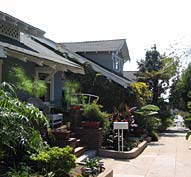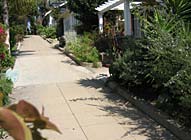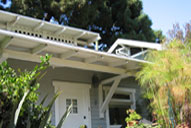




2402 Fourth St. and 2401 Third St.


Hollister court 1904 - 1920s
2402 Fourth St & 2401 Third

Another view

Roof detail
The first bungalow courts appeared in 1909, rumored to be an innovation of architect Sylvanus Marston who built 11 full-sized bungalows in a court arrangement in Pasadena on two standard lots. An East Coast summer resort concept moved west and turned into year-round living, the typical bungalow court featured six to ten individual cottages placed around a communal garden.
Bungalow courts appealed to those who longed for an independent lifestyle while maintaining a strong sense of community and security. Properties around a central piazza were seen as a compromise between expensive, high maintenance single-family homes, and the unnecessary intimacy of apartment life. The bungalow ideology of semi-communal living in a friendly place complemented the Santa Monica lifestyle, so many courtyard complexes were built throughout the area.
In planning and concept, the community court concept was a fine housing alternative for a new segment of home buyers - single women. As office employment and other professional opportunities attracted increasing numbers of young, single women to the city; bungalow courts were advertised as an ideal place for women who were not ready to invest in a single-family home and for those who might not enjoy a large, impersonal apartment building either.
In 1913, an article in Ladies Home Journal concluded that "Very few persons, particularly women, can be happy outside of a pleasant home. An apartment in a great boxlike building is frequently the solution, as a house to one's self is apt to be not only lonely, but expensive as well. In California, the court apartment has solved the problem in a practical and economical way."
The bungalows were like the inside of a yacht - maximum convenience in a minimum of space and furnished with the latest and most serviceable array of built-in features.
Hundreds of bungalow courts were built in California during the 1920s and 1930s. Ironically, outside of the state, the only significant concentrations of bungalow courts were in south Florida and southern Arizona. The rest of the country was building garden apartments, row houses, and semidetached homes.